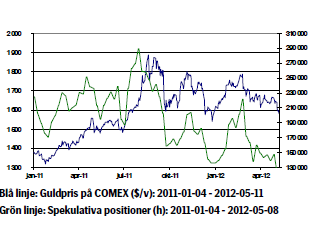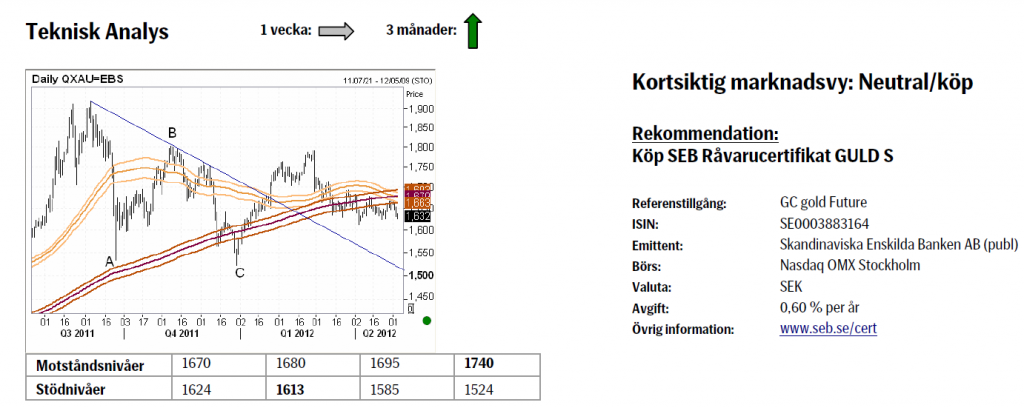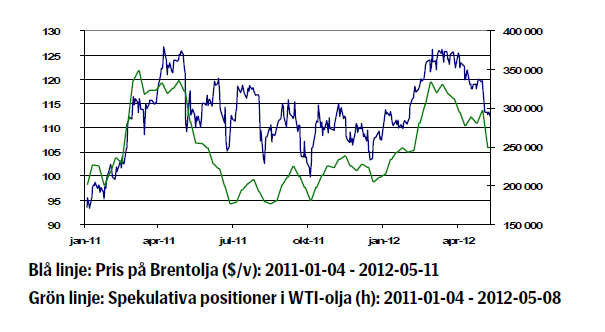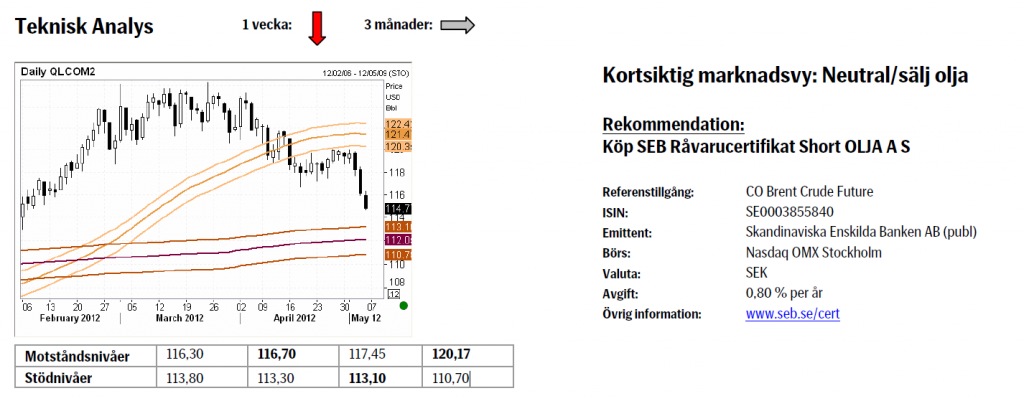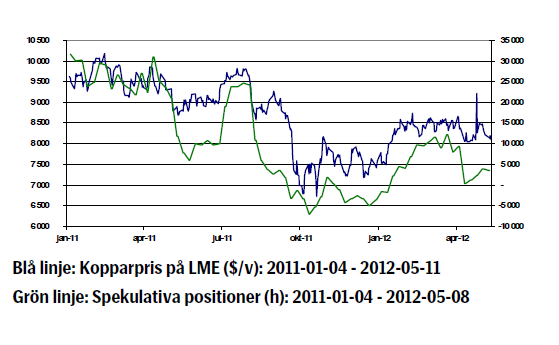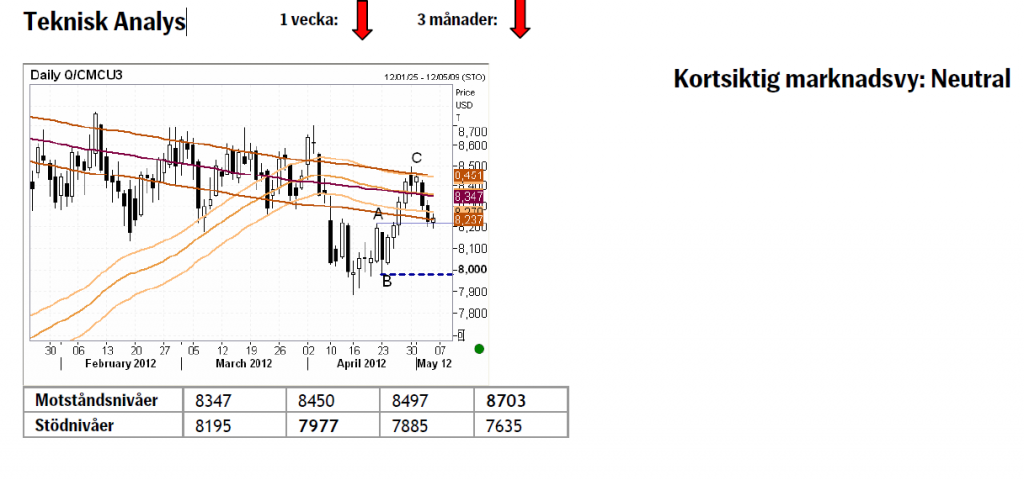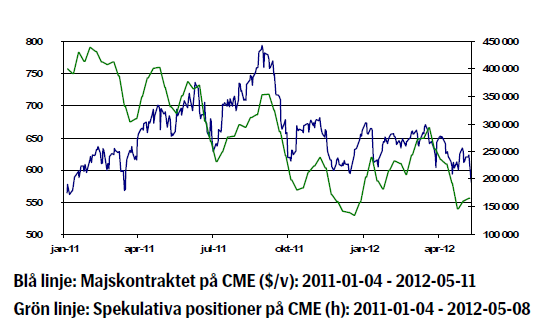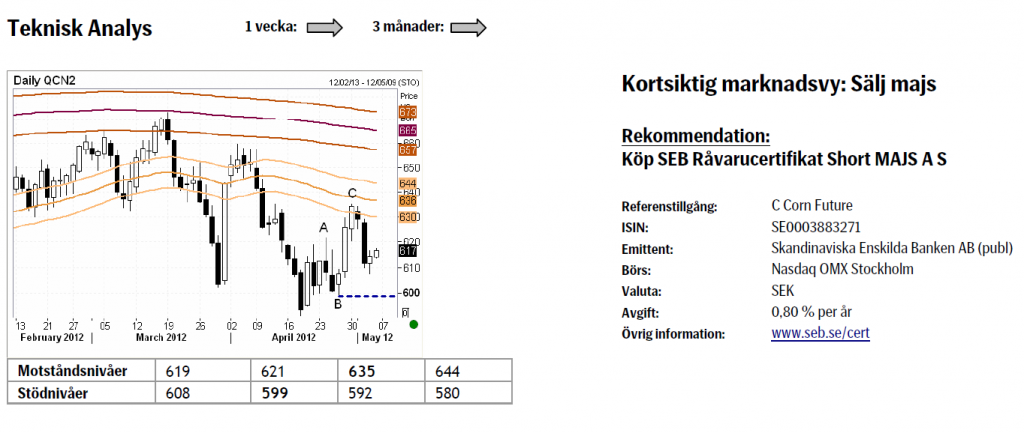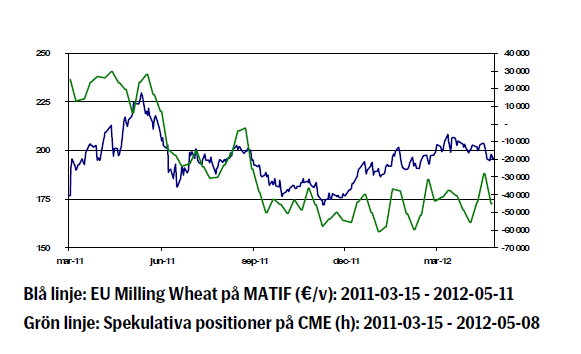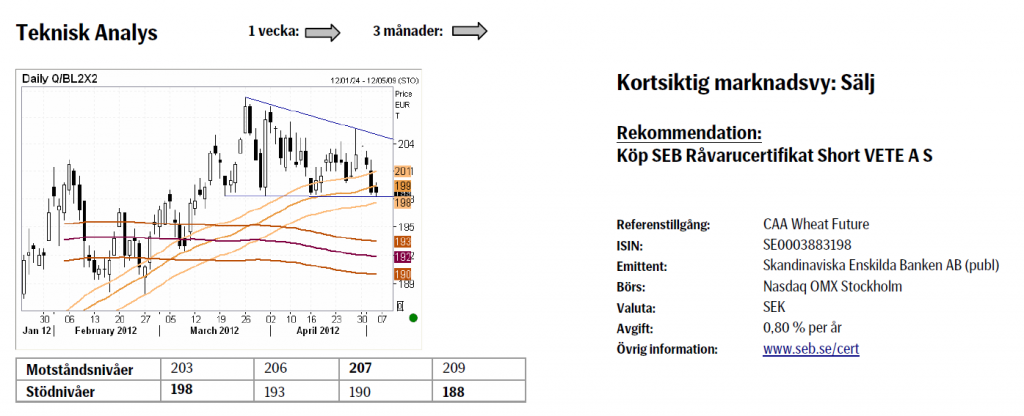Analys
SEB – Råvarukommentarer vecka 20 2012
Sammanfattning: Föregående vecka
 Brett råvaruindex: – 2%
Brett råvaruindex: – 2%
UBS Bloomberg CMCI TR Index- Energi: – 0,34%
UBS Bloomberg CMCI Energy TR Index - Ädelmetaller: – 3,96%
UBS Bloomberg CMCI Precious Metals TR Index - Industrimetaller: – 1,81%
UBS Bloomberg CMCI Industrial Metals TR Index - Jordbruk: – 3,35%
UBS Bloomberg CMCI Agriculture TR Index
Kortsiktig marknadsvy:
- Guld: Neutral/köp
- Olja: Neutral/sälj
- Koppar: Neutral
- Majs: Sälj
- Vete: Sälj
Guld
- Valet i Grekland skapade turbulens. Försöken att bilda regering har misslyckats. Mycket talar för nyval i juni. I slutet av juni är Grekland i behov av nya utbetalningar, men det kräver politiska beslut om nya besparingar för 2013 och 2014.
- Oro över utvecklingen i Grekland och eventuella spridningseffekter har tyngt marknaderna. Spanska 10-åriga obligationer ligger över 6 procent och oron för Spaniens ekonomi är påtaglig. Även i Tyskland ser man nu ett utbrett missnöje med åtstramningar.
- Tyska Bundesbank är villig att acceptera högre tysk inflation i relation till andra euroländers inflation. Detta för att undvika deflation i södra Europa och för att komma till rätta med eurozonens obalanser.
- Guldet föll 3,4 procent och det är uppenbart att guldet inte finner stöd i den systemrisk vi ser i Europa eller i möjligheten till ökad stimulans i form av ökad likviditet. En starkare dollar kan förklara en del av guldets ras men det räcker inte som den enda förklaringen. Vi har sett att utflödet ur guldpositioner skedde i terminsmarknaden medan vi inte såg större utflöden ur fysiska guld ETF: er.
- Korrelationen med andra risktillgångar som råvaror och aktier är hög. Vi tror att vi kan komma att se ytterligare prisfall i denna osäkra makroekonomiska miljö men är benägna att köpa vid större prisfall. Denna vecka är vi neutrala till försiktigt positiva till guldet.
- Teknisk Analys: Fortsatt endast marginella rörelser noterade inom ett redan ganska väl utstakat intervall där under $1620 verkar ”för lågt” och over $1690 ”för högt”. Priset håller sig under ett rullande 55-dagars genomsinittsband. Bandet är svagt i fallande och är på marginalen ett uttryck för visst nedåttryck, men marknaden svarar samtidigt bra på nedställ och i en större positiv bild ser eventuell svaghet ut at vara temporär. Över $1670 & $1695 skulle påvisa efterfrågan och ses som positivt.
Olja
- Oljepriset föll 5,3 Saudiarabiens oljeminister poängterade precis som Opecchefen att man önskar se ett lägre oljepris och att man eventuellt kommer att diskutera en höjning av medlemsländernas produktionskvoter på Opec mötet i juni.
- Saudiarabien kommer att garantera oljeimport till Japan. Japan har starkt behov av oljeimporten eftersom man nu stängt landets alla kärnkraftsverk.
- Även Indien kommer att minska oljeimporten från Iran för att undgå de sanktioner som USA inför i juni. Importen kommer efter ett år att ha minskat med 65 000 fat per dag vilket motsvarar ungefär tre procent av Irans oljeexport.
- Enligt American Petroleum Institute (API) steg råoljelager med 7,8 miljoner fat. Samtidigt bör noteras att lager av oljeprodukter minskade i samma proportion. Även Department of Energy (DOE) visare på onsdagen att råoljelager steg med 3,6 miljoner fat.
- Det dåliga makroekonomiska sentimentet i takt med att situationen i Europa försämras samtidigt som utbudet av olja i marknaden är stort bidrog till oljeprisets fall. Priset verkar ha stabiliserats vid 112 dollar per fat och vi tycker det är svårt att vara positiva på kort sikt.
- Teknisk Analys: Undersidan av 55-dagars bandet (som efter kraftigt nedställ denna vecka är satt i fallande) agerar som dynamisk motstånd (borde inte återtestas under de kommande veckorna). Rörelsen ner är som sagt hård och ska väntas fortsätta för att testa 233-dagars bandet som just nu börjar vid $113.
Koppar
- Kina sänkte i lördags reservkraven för sina största banker med en halv procentenhet till 20 %. Detta var den tredje sänkningen på 6 månader. Denna stimulans väntas öka likviditeten i systemet och kan ge stöd åt kopparpriset. Kinesisk inflationstakt dämpades till 3.4 procent i april från 3.6 procent i mars. Pristrycket är lågt för närvarande och tillväxttakten låg under första kvartalet på den lägsta nivån sedan början av 2009. Kopparpriset föll med 0,8 procent veckan som gick och handlade kort under den viktiga 8000 dollar nivån.
- Kinas handelsstatistik för april var svag. Handelsbalansen steg förvisso men både export och framförallt import föll långt mer än förväntat. Exporten ökade med 4,9 procent jämfört med samma månad året före, väntat var en ökning med 8,5 procent. Importen ökade samtidigt med 0,3 procent, väntat var en ökning med 10,9 procent.
- Industriproduktionen för april steg 9,3 procent jämfört med samma period föregående år. Den var en inbromsning från uppgången om 11,9 procent som noterades i mars, och betydligt under förväntningarna om en uppgång med 12,2 procent.
- Kinas kopparlager föll för femte månaden i rad och föll med 9178 ton till 187449 ton, den lägsta nivån sedan februari. Istället för att importera använder man koppar som finns i lager i landet. Utanför Kina är koppartillgången däremot begränsad och de höga lagernivåerna i Shanghai är en osäkerhetsfaktor.
- Kopparpriset kan fortsätta att pressas eftersom hög kinesisk import tidigare gett stöd åt priset men nu uteblir. Samtidigt kan priset stiga om vi ser att Kina behåller all koppar i landet och den globala marknaden uppvisar en minskad tillgång.
- Teknisk Analys: Rörelsen högre gick något längre än vad som tidigare var trott, men uppsidan av 55-, & 233-dagars ”banden” höll köpare över $8500 nivån borta. Den nuvarande överlappningen under 20 april toppen vid $8218 har ökat sannolikheten att apr/maj rörelsen verkligen är den korrektion vi antagit att den är. Under $$7977 skulle helt bekräfta detta och starkt argumentera för fortsatt rörelse under apr botten vid 7885.
Majs
- Efter att ha handlats över 6 USD/bushel de senaste veckorna föll julikontraktet kraftigt under veckan för att slutligen stänga på 5,81 USD/bushel, en nedgång med 6,33 procent.
- Som vi nämnt i tidigare veckobrev har särskilt den goda efterfrågan från kinesiska boskapsuppfödare agerat stöd den senaste tiden. Torsdagens WASDErapport från det amerikanska jordbruksdepartementet (USDA) fick dock även detta stöd att ge vika.
- I sin rapport justerade USDA upp sin prognos rejält för den amerikanska skörden, där prognosen för landets lagernivå avseende innevarande skördeår justerades upp med över 6 procent jämfört med april månads estimat. Då marknaden förväntade sig en minskning blev följaktligen effekten av rapporten ett rejält prisfall för majsen.
- Fundamentalt ser vi fortsatt ingen anledning att tro på en uppgång för majspriset. Oron i Sydeuropa ökar riskaversionen från investerarkollektivet samtidigt som den goda produktionen minskar intresset från konsumenterna. Vi behåller med detta vår säljrekommendation för majsen.
- Teknisk Analys: Rörelsen upp från apr botten har kommit av sig och börjat se ut som en korrektiv ”3-vågs” rörelse där A-, & C-vågorna nu är symmetriska i storlek och hastighet. Tillbaka under 599 skulle till fullo bekräfta detta och den lätt negativa lutningen på 55-dagars bandet och då argumentera för rörelse under 592, möjligtvis ner mot 580-området.
Vete
- Till skillnad mot sin amerikanska motsvarighet gick vetet i Europa upp något under förra veckan. Detta till stor del baserat på USDA:s jordbruksrapport, i vilken man bedömer att framförallt produktionen i Europa kommer att vara svag under 2012. Det land som kommer att ha störst bortfall är Ukraina, där skörden väntas minska med över 40 procent jämfört med föregående skördeår. Den köldknäpp som drabbade Europa under början av 2012 har fått omfattande konsekvenser och priset på MATIF-vete har sedan årsskiftet gått upp med 1,5 procent. Under samma period har vetepriset i Chicago minskat med nästan 14 procent.
- De senaste veckornas positiva skördeutveckling i USA verkar hålla i sig och det amerikanska jordbruksdepartementet prognostiserar en produktionsökning med 13 procent för landets vintervetesskörd 2012.
- Nu bedömer vi att de största bortfallen avseende den europeiska produktionen är inprisade och ser det som mer troligt att priset kommer att gå ned de kommande veckorna.
- Teknisk Analys: Fallande top Fallande toppar indikerar ett något höjt säljtryck. Skulle stödet just under €200-nivån (& nedsidan på 55-dagars bandet) sluta att attrahera köpare så väntas snabb rörelse tillbaka ner mot stödet vid 233- dagars bandet (som är i fallande) och som börjar vid €193. Över €206 skulle åter minska risken för brott lägre och i stället tas som efterfrågan vid nivåer som tidigare ansågs säljvärda.
[box]SEB Veckobrev Veckans råvarukommentar är producerat av SEB Merchant Banking och publiceras i samarbete och med tillstånd på Råvarumarknaden.se[/box]
Disclaimer
The information in this document has been compiled by SEB Merchant Banking, a division within Skandinaviska Enskilda Banken AB (publ) (“SEB”).
Opinions contained in this report represent the bank’s present opinion only and are subject to change without notice. All information contained in this report has been compiled in good faith from sources believed to be reliable. However, no representation or warranty, expressed or implied, is made with respect to the completeness or accuracy of its contents and the information is not to be relied upon as authoritative. Anyone considering taking actions based upon the content of this document is urged to base his or her investment decisions upon such investigations as he or she deems necessary. This document is being provided as information only, and no specific actions are being solicited as a result of it; to the extent permitted by law, no liability whatsoever is accepted for any direct or consequential loss arising from use of this document or its contents.
About SEB
SEB is a public company incorporated in Stockholm, Sweden, with limited liability. It is a participant at major Nordic and other European Regulated Markets and Multilateral Trading Facilities (as well as some non-European equivalent markets) for trading in financial instruments, such as markets operated by NASDAQ OMX, NYSE Euronext, London Stock Exchange, Deutsche Börse, Swiss Exchanges, Turquoise and Chi-X. SEB is authorized and regulated by Finansinspektionen in Sweden; it is authorized and subject to limited regulation by the Financial Services Authority for the conduct of designated investment business in the UK, and is subject to the provisions of relevant regulators in all other jurisdictions where SEB conducts operations. SEB Merchant Banking. All rights reserved.
Analys
Sell the rally. Trump has become predictable in his unpredictability

Hesitant today. Brent jumped to an intraday high of $66.36/b yesterday after having touched an intraday low of $60.07/b on Monday as Indian and Chinese buyers cancelled some Russian oil purchases and instead redirected their purchases towards the Middle East due to the news US sanctions. Brent is falling back 0.4% this morning to $65.8/b.

It’s our strong view that the only sensible thing is to sell this rally. In all Trump’s unpredictability he has become increasingly predictable. Again and again he has rumbled about how he is going to be tough on Putin. Punish Putin if he won’t agree to peace in Ukraine. Recent rumbling was about the Tomahawk rockets which Trump threatened on 10 October and 12 October to sell/send to Ukraine. Then on 17 October he said that ”the U.S. didn’t want to give away weapons (Tomahawks) it needs”.
All of Trump’s threats towards Putin have been hot air. So far Trump’s threats have been all hot air and threats which later have evaporated after ”great talks with Putin”. After all these repetitions it is very hard to believe that this time will be any different. The new sanctions won’t take effect before 21. November. Trump has already said that: ”he was hoping that these new sanctions would be very short-lived in any case”. Come 21. November these new sanctions will either evaporate like all the other threats Trump has thrown at Putin before fading them. Or the sanctions will be postponed by another 4 weeks or 8 weeks with the appearance that Trump is even more angry with Putin. But so far Trump has done nothing that hurt Putin/Russia. We can’t imagine that this will be different. The only way forward in our view for a propre lasting peace in Ukraine is to turn Ukraine into defensive porcupine equipped with a stinging tail if need be.
China will likely stand up to Trump if new sanctions really materialize on 21 Nov. Just one country has really stood up to Trump in his tariff trade war this year: China. China has come of age and strength. I will no longer be bullied. Trump upped tariffs. China responded in kind. Trump cut China off from high-end computer chips. China put on the breaks on rare earth metals. China won’t be bullied any more and it has the power to stand up. Some Chinese state-owned companies like Sinopec have cancelled some of their Russian purchases. But China’s Foreign Ministry spokesperson Guo Jiakun has stated that China “oppose unilateral sanctions which lack a basis in international law and authorization of the UN Security Council”. Thus no one, not even the US shall unilaterally dictate China from whom they can buy oil or not. This is yet another opportunity for China to show its new strength and stand up to Trump in a show of force. Exactly how China choses to play this remains to be seen. But China won’t be bullied by over something as important as its oil purchases. So best guess here is that China will defy Trump on this. But probably China won’t need to make a bid deal over this. Firstly because these new sanctions will either evaporate as all the other threats or be postponed once we get to 21 November. Secondly because the sanctions are explicit towards US persons and companies but only ”may” be enforced versus non-US entities.
Sanctions is not a reduction in global supply of oil. Just some added layer of friction. Anyhow, the new sanctions won’t reduce the supply of Russian crude oil to the market. It will only increase the friction in the market with yet more need for the shadow fleet and ship to ship transfer of Russian oil to dodge the sanctions. If they materialize at all.
The jump in crude oil prices is probably due to redirections of crude purchases to the Mid-East and not because all speculators are now turned bullish. Has oil rallied because all speculators now suddenly have turned bullish? We don’t think so. Brent crude has probably jumped because some Indian and Chinese oil purchasers of have redirected their purchases from Russia towards the Mid-East just in case the sanctions really materializes on 21 November.
Analys
Brent crude set to dip its feet into the high $50ies/b this week

Parts of the Brent crude curve dipping into the high $50ies/b. Brent crude fell 2.3% over the week to Friday. It closed the week at $61.29/b, a slight gain on the day, but also traded to a low of $60.14/b that same day and just barely avoided trading into the $50ies/b. This morning it is risk-on in equities which seems to help industrial metals a little higher. But no such luck for oil. It is down 0.8% at $60.8/b. This week looks set for Brent crude to dip its feet in the $50ies/b. The Brent 3mth contract actually traded into the high $50ies/b on Friday.

The front-end backwardation has been on a weakening foot and is now about to fully disappear. The lowest point of the crude oil curve has also moved steadily lower and lower and its discount to the 5yr contract is now $6.8/b. A solid contango. The Brent 3mth contract did actually dip into the $50ies/b intraday on Friday when it traded to a low point of $59.93/b.
More weakness to come as lots of oil at sea comes to ports. Mid-East OPEC countries have boosted exports along with lower post summer consumption and higher production. The result is highly visibly in oil at sea which increased by 17 mb to 1,311 mb over the week to Sunday. Up 185 mb since mid-August. On its way to discharge at a port somewhere over the coming month or two.
Don’t forget that the oil market path ahead is all down to OPEC+. Remember that what is playing out in the oil market now is all by design by OPEC+. The group has decided that the unwind of the voluntary cuts is what it wants to do. In a combination of meeting demand from consumers as well as taking back market share. But we need to remember that how this plays out going forward is all at the mercy of what OPEC+ decides to do. It will halt the unwinding at some point. It will revert to cuts instead of unwind at some point.
A few months with Brent at $55/b and 40-50 US shale oil rigs kicked out may be what is needed. We think OPEC+ needs to see the exit of another 40-50 drilling rigs in the US shale oil patches to set US shale oil production on a path to of a 1 mb/d year on year decline Dec-25 to Dec-26. We are not there yet. But a 2-3 months period with Brent crude averaging $55/b would probably do it.
Oil on water increased 17 mb over the week to Sunday while oil in transit increased by 23 mb. So less oil was standing still. More was moving.

Crude oil floating storage (stationary more than 7 days). Down 11 mb over week to Sunday

The lowest point of the Brent crude oil curve versus the 5yr contract. Weakest so far this year.

Crude oil 1mth to 3mth time-spreads. Dubai held out strongly through summer, but then that center of strength fell apart in late September and has been leading weakness in crude curves lower since then.

Analys
Crude oil soon coming to a port near you

Rebounding along with most markets. But concerns over solidity of Gaza peace may also contribute. Brent crude fell 0.8% yesterday to $61.91/b and its lowest close since May this year. This morning it is bouncing up 0.9% to $62.5/b along with a softer USD amid positive sentiment with both equities and industrial metals moving higher. Concerns that the peace in Gaza may be less solid than what one might hope for also yields some support to Brent. Bets on tech stocks are rebounding, defying fears of trade war. Money moving back into markets. Gold continues upwards its strong trend and a softer dollar helps it higher today as well.

US crude & products probably rose 5.6 mb last week (API) versus a normal seasonal decline of 2.4 mb. The US API last night partial and thus indicative data for US oil inventories. Their data indicates that US crude stocks rose 7.4 mb last week, gasoline stocks rose 3.0 mb while Distillate stocks fell 4.8 mb. Altogether an increase in commercial crude and product stocks of 5.6 mb. Commercial US crude and product stocks normally decline by 2.4 mb this time of year. So seasonally adjusted the US inventories rose 8 mb last week according to the indicative numbers by the API. That is a lot. Also, the counter seasonal trend of rising stocks versus normally declining stocks this time of year looks on a solid pace of continuation. If the API is correct then total US crude and product stocks would stand 41 mb higher than one year ago and 6 mb higher than the 2015-19 average. And if we combine this with our knowledge of a sharp increase in production and exports by OPEC(+) and a large increase in oil at sea, then the current trend in US oil inventories looks set to continue. So higher stocks and lower crude oil prices until OPEC(+) switch to cuts. Actual US oil inventory data today at 18:00 CET.
US commercial crude and product stocks rising to 1293 mb in week 41 if last nights indicative numbers from API are correct.

Crude oil soon coming to a port near you. OPEC has lifted production sharply higher this autumn. At the same time demand for oil in the Middle-East has fallen as we have moved out of summer heat and crude oil burn for power for air-conditioning. The Middle-East oil producers have thus been able to lift exports higher on both accounts. Crude oil and condensates on water has shot up by 177 mb since mid-August. This oil is now on its way to ports around the world. And when they arrive, it will likely help to lift stocks onshore higher. That is probably when we will lose the last bit of front-end backwardation the the crude oil curves. That will help to drive the front-month Brent crude oil price down to the $60/b line and revisit the high $50ies/b. Then the eyes will be all back on OPEC+ when they meet in early November and then again in early December.
Crude oil and condensates at sea have moved straight up by 177 mb since mid-August as OPEC(+) has produced more, consumed less and exported more.

-

 Nyheter3 veckor sedan
Nyheter3 veckor sedanGoldman Sachs höjer prognosen för guld, tror priset når 4900 USD
-

 Nyheter4 veckor sedan
Nyheter4 veckor sedanBlykalla och amerikanska Oklo inleder ett samarbete
-

 Nyheter4 veckor sedan
Nyheter4 veckor sedanGuld nära 4000 USD och silver 50 USD, därför kan de fortsätta stiga
-

 Nyheter2 veckor sedan
Nyheter2 veckor sedanLeading Edge Materials är på rätt plats i rätt tid
-

 Nyheter3 veckor sedan
Nyheter3 veckor sedanNytt prisrekord, guld stiger över 4000 USD
-

 Nyheter4 veckor sedan
Nyheter4 veckor sedanEtt samtal om guld, olja, koppar och stål
-

 Analys4 veckor sedan
Analys4 veckor sedanOPEC+ will likely unwind 500 kb/d of voluntary quotas in October. But a full unwind of 1.5 mb/d in one go could be in the cards
-

 Nyheter4 veckor sedan
Nyheter4 veckor sedanNeptune Energy bekräftar enorma litiumfyndigheter i Tyskland


